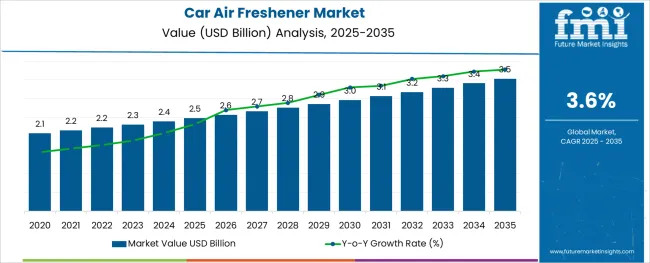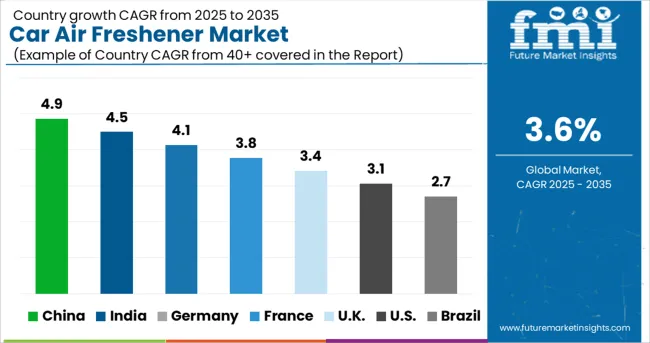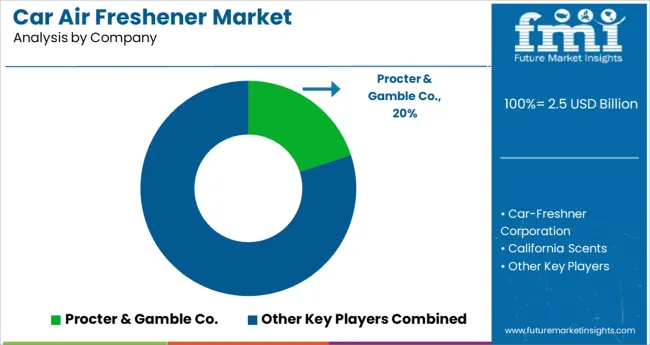The Car Air Freshener Market is estimated to be valued at USD 2.5 billion in 2025 and is projected to reach USD 3.5 billion by 2035, registering a compound annual growth rate (CAGR) of 3.6% over the forecast period.

The alginic acid market is undergoing consistent growth, propelled by rising demand from food processing, pharmaceutical formulations, and cosmetic applications. A growing focus on natural and sustainable ingredients in manufacturing processes has positioned alginic acid as a preferred biopolymer across industries.
The market is further supported by its diverse functional benefits, including water retention, gelling, and stabilizing properties, which make it indispensable in high-performance formulations. Increased regulatory acceptance of alginates as safe additives and the push towards cleaner labeling in food and personal care products have reinforced their adoption.
Ongoing innovation in extraction technologies and the utilization of algae as a renewable resource are paving the way for cost-effective production and expanded applications, ensuring sustained market expansion in the coming years.
The market is segmented by Product Type, Product Form, Price Range, and Sales Channel and region. By Product Type, the market is divided into Hanging, Clip-on, Plug-ins, Spray/Aerosol, Paper, and Other. In terms of Product Form, the market is classified into Gel, Crystal, Foam, Liquid, Powder, and Other. Based on Price Range, the market is segmented into Medium, Low, and Premium. By Sales Channel, the market is divided into Hypermarkets/Supermarkets, Convenience Stores, Departmental Stores, Independent Stores, Online Retailers, and Others. Regionally, the market is classified into North America, Latin America, Western Europe, Eastern Europe, Balkan & Baltic Countries, Russia & Belarus, Central Asia, East Asia, South Asia & Pacific, and the Middle East & Africa.
When segmented by salts, sodium alginate is expected to command 27.5% of the market revenue in 2025, marking it as the leading subsegment in this category. This leadership has been driven by its superior solubility, ease of incorporation into formulations, and versatility in a wide range of applications.
Its ability to form stable gels and maintain viscosity under varying conditions has made it highly sought after in both food and pharmaceutical sectors. Manufacturers have prioritized sodium alginate due to its consistent performance, cost-effectiveness, and regulatory acceptance, which have collectively strengthened its position.
The segment’s prominence has also been enhanced by its adaptability to evolving consumer preferences for plant-derived and sustainable ingredients, reinforcing its market share.
Segmented by end user industry, the food industry is projected to hold 33.0% of the market revenue in 2025, positioning it as the most prominent sector. This dominance has been shaped by the industry’s increasing reliance on alginic acid and its derivatives to deliver desirable textures, stabilize emulsions, and improve shelf life of processed foods.
As consumer demand for clean label and natural additives has intensified, the food sector has responded by integrating alginates into bakery, dairy, and confectionery products. Enhanced production efficiency and compliance with food safety standards have further encouraged widespread use.
The segment’s leadership has also been supported by product differentiation strategies where alginates contribute to premium quality and innovation, securing their role in modern food formulations.
When analyzed by functionality, thickening agents are forecast to account for 29.0% of the market revenue in 2025, establishing themselves as the dominant functional category. This preeminence has been underpinned by the growing need for consistent texture and viscosity in a wide array of end products.
Alginic acid’s natural origin and high efficiency in creating uniform, stable thickness without altering taste or color have solidified its appeal. The demand for thickeners in both edible and topical applications has expanded, with manufacturers leveraging its rheological properties to meet performance and regulatory requirements.
The functionality’s leading share has also been reinforced by the ability to deliver cost savings through lower dosages and its compatibility with other ingredients, securing its position as an indispensable component in formulation strategies.
In the last few years, companies have made significant progress in terms of the development of new environmentally sustainable products. They have also adapted new ways of manufacturing that are set to boost the market. In the car accessories market, air fresheners are nowadays considered to be the current trend.
Increasing innovation from manufacturers in the market has boosted it to new heights. Key players in the market are investing large amounts of their resources in research & development (R&D) practices and are coming up with various strategies to attract an increasing number of consumers.
Besides, as air fresheners can be used in different circumstances such as on a vent, on the mirror, as a pendant, or on a key chain, their demand is likely to surge in the global market.
Moreover, the increasing trend for car maintenance among consumers is expected to subsequently boost the demand for car air fresheners in the next ten years. The availability of car air fresheners at numerous locations such as car wash centers, independent stores, and convenience stores is also increasing product visibility and helping the market to grow.
Owing to the aforementioned factors, the global car air freshener market is anticipated to increase at a substantial growth rate of ~3.6% during the forecast period, over the ~3.2% growth rate experienced during the historical period of 2020 to 2024.
Increasing Sales of Four Wheelers to Push the Demand for Car Fragrances
In the past few years, there has been a significant rise in terms of sales of automobiles across the globe. The inflow of new brands in the automobile industry on the back of the growing preference of consumers to travel by four-wheelers is boosting sales of car air fresheners.
Car air fresheners can also help to enhance the aroma inside a car. The increasing number of automobiles on the road owing to better transportation facilities offered by government agencies is boosting the demand for car air fresheners in the market. Moreover, the need for consumers to eradicate bad smells inside a vehicle and to inhale fresh air is aiding growth in the global market.
Awareness about Potentially Hazardous Compounds May Obstruct Sales of Car Scents
Air fresheners emit a wide range of toxic chemicals that are often classified as hazardous in nature. A study by Springer Nature, for instance, revealed that air fresheners emitted approximately 546 volatile organic compounds (VOCs). Amongst these, about 30 VOCs were classified as potentially hazardous.
All types of air fresheners emitted one or more potentially hazardous compounds. The study further revealed that car air fresheners can lead to the emission of various volatile compounds such as hazardous VOCs. Thus, rising awareness about the hazardous impacts of car air fresheners may hinder product sales during the forecast period.

Rising Demand for Sustainable Car Perfumes in the USA to Bode Well for Manufacturers
The USA is one of the leading markets for car air fresheners. The country is set to generate an exponential demand during the evaluation period. The USA is estimated to exhibit a significant market share of around 75% by the end of 2025.
The presence of some of the top brands with extensive and unlimited product portfolios on the back of a high pool of loyal consumers is expected to push the country’s market.
Besides, the increased preference of consumers for sustainable and eco-friendly air fresheners that would not damage health or the environment is likely to create substantial growth opportunities in the USA market.
Availability of Low-cost Resources to Produce Car Air Freshener Sprays in China to Propel Demand
China is set to be one of the largest hubs for air freshener manufacturers in East Asia. It is anticipated to hold a market share of over 60% in East Asia and is set to grow at a CAGR of ~7.4% during the forecast period.
The country is considered to be one of the world’s dominant markets in terms of the manufacturing of air improvement goods and fragrances. Efficient manufacturing capabilities with low cost of production and availability of vast resources have attracted a large number of market players to establish their manufacturing base in the country.
Alternatively, it has resulted in a significant share of countries in the East Asia region.
High Demand for Car Freshener Sprays Infused with Natural Ingredients to Spur Sales in India
India is one of the emerging markets for car air fresheners and is anticipated to grow with rising awareness regarding environmental safety. In addition, citizens of the country are set to be highly inclined toward natural products and as a result, natural car air fresheners are generating surging demand in India.
Consumers in the country are nowadays looking for natural ingredients-based products from chemical compound products. A huge base of customers in India prefers natural and eco-friendly produced goods. Therefore, this factor is set to encourage Indian manufacturers to use natural ingredients in the production of car air fresheners.
Hanging Car Freshener Gels to Gain Impetus as Customers Look for Long-lasting Fragrances
According to a recent analysis by FMI, based on product type, the hanging air freshener segment is anticipated to exhibit a growth rate of over 7.5% during the forecast period. Hanging air freshener is set to be a highly lucrative category and it is increasingly gaining popularity worldwide.
The target product is gaining prominence on the back of various factors such as ease of usability, use & throw ability, availability of a broad range of fragrances, and low cost of products with long-lasting durability. In order to switch to different fragrances over a short time span, consumers are mainly opting for hanging air fresheners for their cars, which is gaining impetus in the market.
Customers Prefer Medium-Priced Car Spray Perfumes owing to Bulk Buying Practices
In terms of the price range, medium-priced car air fresheners are expected to hold a significant share of around 50% of the market. The premium category of air fresheners is likely to exhibit the highest growth rate during the forecast period among other segments.
The trend of consumers buying air fresheners in bulk capacity has inclined them to opt for products that are priced moderately. The inflow of consumers in hypermarkets/supermarkets due to the easy availability of medium-priced products has increased over the last few years. It is anticipated to boost sales of medium-priced air fresheners in the next ten years.

Leading players operating globally in the market are focusing on partnerships, new product developments, and innovative product launches in order to expand their businesses. A few other key companies are aiming to join hands with local firms to co-develop unique fragrances to meet the surging demand from customers across the globe.
For instance,
| Attribute | Details |
|---|---|
| Estimated Market Size (2025) | USD 2.5 billion |
| Projected Market Valuation (2035) | USD 3.5 billion |
| Value-based CAGR (2025 to 2035) | 3.6% |
| Forecast Period | 2025 to 2035 |
| Historical Data Available for | 2020 to 2024 |
| Market Analysis | Value (million) |
| Key Regions Covered | North America; Latin America; Europe; East Asia; South Asia; Oceania & MEA |
| Key Countries Covered | The United States, Canada, Brazil, Mexico, Germany, the United Kingdom, France, Spain, Italy, Russia, South Africa, Northern Africa GCC Countries, China, Japan, South Korea, India, Thailand, Malaysia, Indonesia, Australia & New Zealand. |
| Key Segments Covered | Product Type, Product Form, Price Range, Sales Channel, and Region |
| Key Companies Profiled | Procter & Gamble Co.; Car-Freshener Corporation; California Scents; Church & Dwight Co. Inc.; Godrej Household Products; Reckitt Benckiser Group Plc.; Amway; Kobayashi; Liby; Houdy; Farcent; Jiali; Other (on request) |
| Report Coverage | Market Forecast, Company Share Analysis, Competition Intelligence, DROT Analysis, Market Dynamics and Challenges, and Strategic Growth Initiatives |
The global car air freshener market is estimated to be valued at USD 2.5 billion in 2025.
It is projected to reach USD 3.5 billion by 2035.
The market is expected to grow at a 3.6% CAGR between 2025 and 2035.
The key product types are hanging, clip-on, plug-ins, spray/aerosol, paper and other.
gel segment is expected to dominate with a 33.0% industry share in 2025.






Full Research Suite comprises of:
Market outlook & trends analysis
Interviews & case studies
Strategic recommendations
Vendor profiles & capabilities analysis
5-year forecasts
8 regions and 60+ country-level data splits
Market segment data splits
12 months of continuous data updates
DELIVERED AS:
PDF EXCEL ONLINE
Carboxymethyl Tamarind Kernel Powder Market Size and Share Forecast Outlook 2025 to 2035
Car Tail Light Mould Market Size and Share Forecast Outlook 2025 to 2035
Car OS Market Size and Share Forecast Outlook 2025 to 2035
Caramel Malt Market Size and Share Forecast Outlook 2025 to 2035
Carbon Capture and Sequestration Market Forecast Outlook 2025 to 2035
Cardiac Rehabilitation Market Size and Share Forecast Outlook 2025 to 2035
Carbon Dioxide Incubators Market Size and Share Forecast Outlook 2025 to 2035
Carboxymethyl Tamarind Gum (CMT) Market Size and Share Forecast Outlook 2025 to 2035
Car Cover Market Size and Share Forecast Outlook 2025 to 2035
Cardiology Information System Market Size and Share Forecast Outlook 2025 to 2035
Cardiopulmonary Functional Testing Platform Market Size and Share Forecast Outlook 2025 to 2035
Carbon Enhanced Lead Acid Battery Market Size and Share Forecast Outlook 2025 to 2035
Car Bushing Market Size and Share Forecast Outlook 2025 to 2035
Carbon-negative Cement Market Size and Share Forecast Outlook 2025 to 2035
Card Printer Ribbon Market Size and Share Forecast Outlook 2025 to 2035
Carbon Tetrabromide Market Size and Share Forecast Outlook 2025 to 2035
Carbon Steel Market Size and Share Forecast Outlook 2025 to 2035
Carpet Spot Remover Market Size and Share Forecast Outlook 2025 to 2035
Cardiovascular CT Systems Market Size and Share Forecast Outlook 2025 to 2035
Carbon Brush Market Size and Share Forecast Outlook 2025 to 2035

Thank you!
You will receive an email from our Business Development Manager. Please be sure to check your SPAM/JUNK folder too.
Chat With
MaRIA